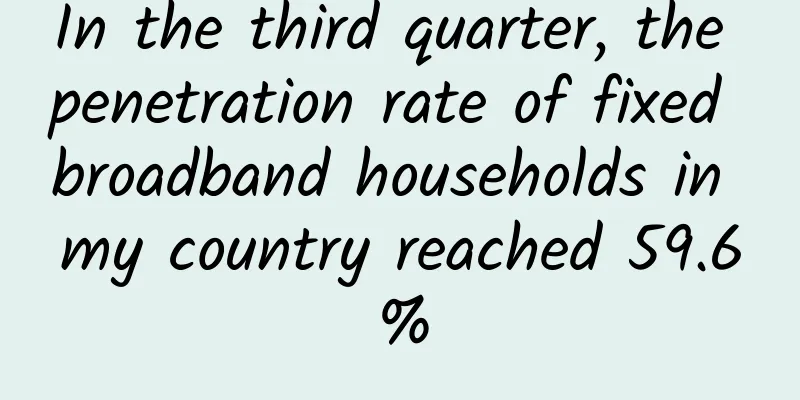In the third quarter, the penetration rate of fixed broadband households in my country reached 59.6%

|
According to the "China Broadband Penetration Report" for the third quarter of 2016 released by the Broadband Development Alliance on November 28, as of the third quarter of 2016, the fixed broadband household penetration rate in my country reached 59.6%, an increase of 3 percentage points from the second quarter; the mobile broadband user penetration rate reached 67.7%, an increase of 3.9 percentage points from the second quarter. Industry insiders believe that based on the huge number of broadband users in my country, the penetration rate of broadband users is still increasing rapidly at a rate of more than 3 percentage points per quarter, indicating that my country's broadband user penetration has achieved significant results. Data shows that in the third quarter of 2016, the number of household fixed broadband users in my country exceeded 270 million, an increase of more than 13 million households from the second quarter; the number of mobile broadband (mainly 3G and 4G) users exceeded 920 million, an increase of more than 53 million households from the second quarter, and the penetration of broadband users has improved significantly. Judging from the regional broadband development and popularization, the fixed broadband household penetration rate and mobile broadband user penetration rate both show that the eastern region is significantly ahead, while the western region is higher than the central region. In terms of broadband development and penetration in various regions, Zhejiang Province ranks first in fixed broadband household penetration rate, reaching 92.5%, and Jiangsu Province, Beijing, Guangdong Province, and Shanghai are also in the top five. In terms of mobile broadband user penetration rate, Beijing, Shanghai, and Guangdong Province rank in the top three, all exceeding 100%, and Zhejiang Province and Jiangsu Province are also in the top five. In recent years, the competent authorities of the communications industry have accelerated the construction of information infrastructure such as optical fiber and 4G networks, implemented pilot projects for universal telecommunications services, vigorously promoted broadband information applications, and continuously promoted the rapid development and popularization of broadband in my country. |
>>: Before 5G arrives, let’s talk about what Gigabit LTE is
Recommend
CloudCone Black Friday promotion, KVM annual payment starts from $14.2, supports Alipay, Los Angeles data center
CloudCone has once again released this year's...
Survey: U.S. users are dissatisfied with internet service providers, with satisfaction ranking near the bottom
On June 8, a research organization recently relea...
What does 5G high and low frequency networking mean?
[[346977]] This article is reprinted from the WeC...
Building a new digital paradigm and creating new industry value | Huawei works with partners to create and promote 100 typical scenario-based solutions
[Shanghai, China, September 23, 2020] During HUAW...
2018 Trends: What will the future hold for AI and IoT?
What kind of chemical reaction will occur between...
I experienced 5G network on Beijing Line 16 for a while and used up 7GB of data
What is 5G? Do I need to change my SIM card? Can ...
Industrial Internet + 5G, we must plan carefully before taking action
In the previous article, "IoT operating syst...
Akamai Releases 2021 Annual Sustainability Report
March 14, 2022 - Akamai Technologies, Inc. (Akama...
In addition to 404, what other "codes" are there for web pages?
404 Not Found When surfing the Internet, whether ...
ChangeIP: High-security VPS monthly payment starts at $2.39, unlimited traffic VPS annual payment starts at $19.2, optional Los Angeles/Denver/Chicago/Netherlands data centers
ChangeIP is a site under Sharktech's data cen...
Intelligent connectivity: the convergence of 5G with AI, IoT and AR
Although it is still too early to truly measure t...
5G and the Internet of Things: Connecting Millions of Devices
As the number of connected devices continues to g...
Riverbed Redefines APM, Helps Enterprises Promote Digital Transformation
[51CTO.com original article] It is obvious that d...
Enterprise router purchasing: Start by reviewing border routers
In the past, routers had only one purpose - to ro...
Comprehensively promote IPv6 and completely change network life
If you have been following the developments in ne...









